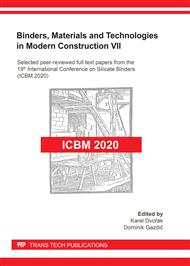[1]
H. Xu, J.S.J. Van Deventer, Geopolymerisation of multiple minerals, Minerals Engineering, Volume 15, Issue 12, December 2002, Pages 1131-1139.
DOI: 10.1016/s0892-6875(02)00255-8
Google Scholar
[2]
Davidovits J., Davidovits M., Davidovits N., 1994. Process for obtaining a geopolymeric alumino-silicate and products thus obtained. US Patent, 5342595.
Google Scholar
[3]
Rakhimova, N.R., A review of calcined clays and ceramic wastes as sources for alkali-activated materials, Geosystem Engineering, Volume 23, Issue 5, 2 September 2020, Pages 287-298.
DOI: 10.1080/12269328.2020.1768154
Google Scholar
[4]
Provis J.L., Alkali-activation of calcined clays – past, present and future, RILEM Bookseries, Volume 16, 2018, Pages 372-376, 2nd International Conference on Calcined Clays for Sustainable Concrete, 2017; Havana; Cuba; 5 December 2017 through 7 December 2017; Code 203349.
DOI: 10.1007/978-94-024-1207-9_60
Google Scholar
[5]
Jaskulski R., Jóźwiak-Niedźwiedzka, D., Yakymechko, Y., Calcined clay as supplementary cementitious material, Materials, 13[21] 2020, Article number 4734, Pages 1-36.
DOI: 10.3390/ma13214734
Google Scholar
[6]
Ogundiran M.B., Kumar S., Synthesis of fly ash-calcined clay geopolymers: Reactivity, mechanical strength, structural and microstructural characteristics, Construction and Building Materials, 125, 2016, 450-457.
DOI: 10.1016/j.conbuildmat.2016.08.076
Google Scholar
[7]
J. Kiventera, I. Lancellotti, M. Catauro, F. Dal Poggetto, C. Leonelli, M. Illikainen, Alkali activation as new option for gold mine tailings inertization, Journal of Cleaner Production, 187 (2018) 76-84.
DOI: 10.1016/j.jclepro.2018.03.182
Google Scholar
[8]
I. Lancellotti, C. Ponzoni, L. Barbieri, C. Leonelli, Alkali activation processes for incinerator residues management, Waste Management ,33 (2013) 1740-1749.
DOI: 10.1016/j.wasman.2013.04.013
Google Scholar
[9]
Barone, G., Finocchiaro, C., Lancellotti, I., Leonelli, C., Mazzoleni, P., Sgarlata, C., Stroscio, A., Potentiality of the Use of Pyroclastic Volcanic Residues in the Production of Alkali Activated Material, Waste and Biomass Valorization, in press (2020).
DOI: 10.1007/s12649-020-01004-6
Google Scholar
[10]
B. Sri Umniati, P. Risdanareni, F. T. Zulfikar Zein, Workability enhancement of geopolymer concrete through the use of retarder, AIP Conference Proceedings 1887, 020033 (2017).
DOI: 10.1063/1.5003516
Google Scholar
[11]
D. Hardjito, C. C. Cheak, C. H. L. Ing, Strength and Setting Times of Low Calcium Fly Ash-based Geopolymer Mortar, Modern Applied Science, Volume 2, No .4, July (2008).
DOI: 10.5539/mas.v2n4p3
Google Scholar
[12]
C. Finocchiaro, G. Barone, P. Mazzoleni, C. Sgarlata, I. Lancellotti, C. Leonelli, M. Romagnoli, Artificial neural networks test for the prediction of chemical stability of pyroclastic deposits-based AAMs and comparison with conventional mathematical approach (MLR)", Journal of Materials Science, 56 (2021) 513–527.
DOI: 10.1007/s10853-020-05250-w
Google Scholar
[13]
C. Sgarlata, Internal Report, University of Modena and Reggio Emilia, (2019).
Google Scholar


